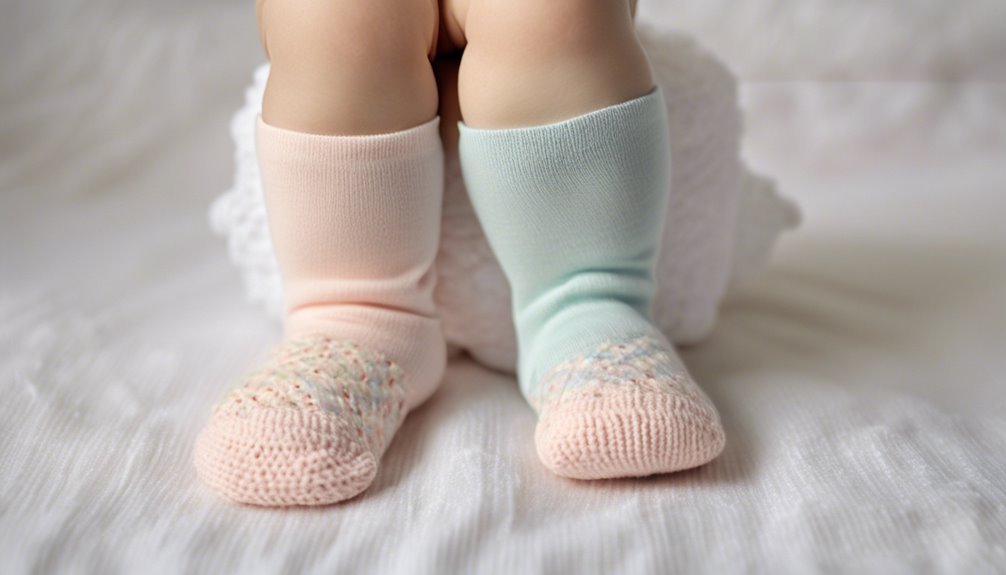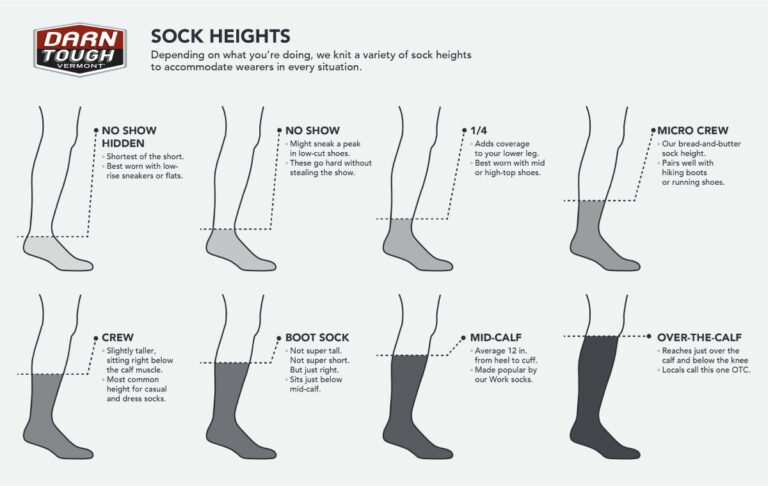Baby Socks vs. Toddler Socks: What’s the Difference?
When comparing baby socks and toddler socks, you'll notice key differences in size, fit, and material. Baby socks are designed for infants, offering softer, stretchier fabrics for maximum comfort. In contrast, toddler socks feature thicker, more durable materials with non-slip soles for safety during play. Proper fit is essential for both age groups to prevent discomfort. Understanding these nuances can help you make better choices for your child's needs, and more insights await to guide you further.
Understanding Baby Socks

When you're shopping for baby socks, it's vital to understand their unique features and benefits. Baby sock styles vary widely, from classic crew lengths to cozy booties, and each serves a different purpose. For instance, booties can keep tiny feet warm while providing a secure fit, fundamental for those first months. Fabric choices also matter—opt for breathable cotton or soft bamboo blends to guarantee comfort against delicate skin. These materials help prevent irritation and allow for breathability, essential for active babies. When you consider these factors, you empower yourself to make informed decisions that support your baby's comfort and freedom of movement. Prioritizing both style and functionality will help you find the perfect pair for your little one.
Characteristics of Toddler Socks
Toddler socks are designed to meet the active lifestyle of your little ones, combining comfort, durability, and safety. These socks often feature various toddler sock patterns, appealing to your child's personality while guaranteeing they stay engaged. Additionally, they come in different toddler sock lengths, catering to various activities, whether it's playtime or naptime.
| Feature | Description | Benefits |
|---|---|---|
| Sock Patterns | Stripes, animals, or cartoon characters | Keeps your toddler excited about wearing them |
| Sock Length | Ankle, crew, or knee-high | Provides options for warmth and mobility |
| Material | Cotton blends or bamboo fibers | Guarantees softness and breathability |
| Grip | Non-slip soles | Enhances safety during active play |
| Size Range | 2T to 5T | Accommodates growth and different sizes |
Importance of Fit and Comfort
Finding the right fit and comfort in toddler socks is essential for both your child's happiness and their safety. As toddlers become more active, the importance of proper sock sizes can't be overstated. Ill-fitting socks can lead to discomfort, restricting movement and even causing blisters. It's vital to choose socks that offer the right balance of snugness and flexibility, ensuring your child can explore freely. Pay attention to comfort levels, as soft, breathable materials can enhance their overall experience. When you prioritize fit and comfort, you're not just selecting an accessory; you're supporting your child's growth and independence. After all, happy feet lead to happy adventures, and every small detail counts in their journey of exploration.
Material and Durability Differences

While you might not think about it, the material and durability of socks can markedly impact your child's daily activities. Baby socks often use softer, stretchier fabric types like cotton blends, prioritizing comfort for delicate feet. On the other hand, toddler socks are designed with more robust materials, ensuring they withstand the wear and tear of active play. You'll find fabric types including thicker cotton or even moisture-wicking blends, enhancing durability and comfort for your little explorer. When considering longevity expectations, toddler socks typically last longer due to their sturdier construction. Choosing the right sock not only supports your child's comfort but also allows them the freedom to move and play without worry. Your choice makes a difference!
Safety Features in Toddler Socks
When it comes to keeping little feet safe during playtime, the safety features in toddler socks play an essential role. You'll want to look for socks with effective grip patterns and non-slip features to help prevent slips and falls as your child explores. These elements are designed to enhance traction on various surfaces, giving your toddler the freedom to move without worry. Additionally, many toddler socks are crafted with snug fits, ensuring they stay securely on those active little feet. By choosing socks with these safety features, you're not just protecting your child but also encouraging their independence and confidence as they learn to navigate their environment. Investing in quality socks can make a significant difference in their playful adventures.
Choosing the Right Socks for Each Stage
When choosing socks for your little ones, it's essential to take into account their size and fit, as well as their material and comfort needs. Babies require softer, stretchier fabrics, while toddlers benefit from sturdier options that support their active play. Additionally, the design and functionality should match their developmental stage to guarantee both safety and practicality.
Size and Fit Differences
Choosing the right socks for your little one can make a significant difference in their comfort and mobility, especially as they grow from baby to toddler. Understanding size measurements and fit guidelines is essential for ensuring a proper fit.
- Baby socks typically range from sizes 0-12 months, with a snug fit to prevent slipping.
- Toddler socks usually cover sizes 1-4T, offering more room for growing feet.
- Look for features like stretchy materials to accommodate foot development.
As you select socks, consider how a proper fit can impact your child's ability to crawl or walk. Ensuring the right size not only enhances comfort but also promotes freedom of movement, allowing your little explorer to thrive at every stage!
Material and Comfort Needs
As your child grows, the materials used in their socks become just as important as the fit. For babies, prioritize material softness to protect their delicate skin. Soft cotton blends or bamboo are excellent choices that keep little feet comfortable and warm.
As toddlers become more active, their comfort preferences shift. Look for socks with breathable fabrics that can withstand their adventures. Performance materials like moisture-wicking fibers can help regulate temperature and prevent irritation.
Consider your child's sensitivities and preferences; some might prefer a snug fit, while others may enjoy looser styles. Ultimately, choosing the right material not only enhances comfort but also supports their exploration, allowing them the freedom to move and play without restrictions.
Design and Functionality Variations
While the shift from baby to toddler socks might seem straightforward, the design and functionality variations play an essential role in your child's development and comfort. As toddlers become more active, their socks need to adapt to their growing independence.
Consider these key aspects when choosing socks:
- Grip and traction: Look for non-slip soles to prevent slips and falls.
- Style preferences: Toddlers begin to express their individuality, so let them choose patterns or characters they love.
- Color options: Vibrant colors can make sock-wearing exciting and fun for your little one.
Frequently Asked Questions
Can Baby Socks Be Used for Toddlers?
You can use baby socks for toddlers, but they might not fit well due to toddler sock sizes. Additionally, baby sock materials may lack durability, which could limit comfort and support for your growing child.
How Many Pairs of Socks Do Babies Need?
You'll want to aim for about six to eight pairs of socks for your baby. Consider sock material for comfort and size considerations to guarantee a snug fit, allowing your little one to move freely.
What Colors and Patterns Are Available for Baby Socks?
When choosing baby socks, you'll find a delightful variety of color options and pattern choices. From vibrant hues to cute designs, these socks can express your little one's personality while keeping their tiny feet cozy.
Are Socks Essential for Newborns?
Research shows that newborns lose up to 30% of their body heat through their extremities. To maintain newborn warmth, soft sock materials like cotton or bamboo are essential, ensuring their comfort and helping regulate body temperature.
When Should I Start Buying Toddler Socks?
You should start buying toddler socks when your child begins walking. Look for toddler sock features like non-slip grips and stretchy materials that accommodate active feet, ensuring comfort and safety during their explorative adventures.






